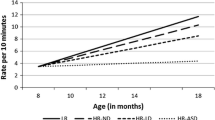Abstract
Two mathematical models of social contingency are examined in terms of their development over the first year of life. The interactions of 53 mothers and their infants were recorded at 6 weeks, 4 months, and 12 months. The infants' gazes at 6 weeks, the mothers' vocal behavior at 6 weeks, and the vocal behavior of the mother and infant at 4 and 12 months were automatically coded in terms of four states. The conditional dependence model and the response effects model were computed for each interaction at each age, and the coefficients of the models were examined as a function of age. The relative success of the models as estimates of moment-to-moment contingency as well as their variations with age are discussed.
Similar content being viewed by others
References
Bahrick, L. E. (1983). Infants' perception of substance and temporal synchrony in multimodal events.Infant Behavior and Development, 6, 429–451.
Beckwith, L., Sigman, M., Cohen, S., & Parmelee, A. (1977). Vocal output in preterm infants.Developmental Psychobiology, 10, 543–554.
Bushnell, E., Weinberger, N., & Sasserville, A. (1989 April).Interactions between vision and touch during infancy: The development of cooperative relations and specializations. Poster presented at the Biennial Meeting of the Society for Research in Child Development, Kansas City, MO.
Cohn, J., & Tronick, E. (1988). Mother-infant face-to-face interaction: Influence is bidirectional and unrelated to periodic cycles in either partner's behavior.Developmental Psychology, 24, 386–392.
DeCasper, A. J., & Spence, M. J. (1991). Auditorially mediated behavior during the perinatal period: A cognitive view. In M. J. S. Weiss & P. R. Zelazo (Eds.),Newborn attention: Biological constraints and the influence of experience. Norwood, NJ: Ablex, 525.
Feldstein, S., Jaffe, J., Beebe, B., Crown, C. L., Jasnow, M. J., Fox, H., & Gordon, S. (1993). Coordinated interpersonal timing in adult-infant vocal interactions: A crosssite replication.Infant Behavior and Development, 16, 455–470.
Jaffe, J., & Feldstein, S. (1970).Rhythms of dialogue. New York: Academic Press.
Jaffe, J., Feldstein, S., & Cassotta, L. (1967). Markovian models of dialogic time patterns.Nature, 216, 93–94.
Jaffe, J., Stern, D. N. & Peery, J. C. (1973). “Conversational” coupling of gaze behavior in prelinguistic human development.Journal of Psycholinguistic Research, 2, 321–329.
Lester, B., Hoffman, J., & Brazelton, T. (1985). The rhythmic structure of mother-infant interaction in term and preterm infants.Child Development, 56, 15–27.
Meltzoff, A. N., Kuhl, P. K., & Moore, M. K. (1991). Perception, representation, and the control of action in newborns and young infants: Toward a new synthesis. In M. J. S. Weiss & P. R. Zelazo (Eds.),Newborn attention. Norwood, NJ: Ablex, 377–411.
Pedhazur, E. J. (1982).Multiple regression in behavioral research: Explanation and prediction. New York: Holt, Rinehart & Winston.
Rose, S., & Ruff, H. A. (1987). Cross-modal abilities in human infancy. In J. D. Osofsky (Ed.),Handbook'of infant development (2nd ed., pp. 318–363). New York: Wiley.
Stark, R. (1981). Infant vocalization: A comprehensive view.Infant Mental Health Journal, 2, 118–128.
Stern, D. N. (1971). A micro-analysis of mother-infant interaction: Behavior regulating social contact between a mother and her 31/2-month-old twins.Journal of the American Academy of Child Psychiatry, 10, 501–517.
Thomas, E. A. C., & Malone, T. W. (1979). On the dynamics of two-person interactions.Psychological Review, 86, 331–360.
Thomas, E. A. C., & Martin, J. A. (1976). Analyses of parent-infant interaction.Psychological Review, 83, 141–156.
Wickens, T. D. (1982).Models for behavior: Stochastic processes in psychology. San Francisco: Freeman.
Wolff, P. H. (1966). The causes, control and organization of behavior in the neonate.Psychological Issues Monographs,5 (1, Whole No. 17).
Zeskind, P., & Marshall, T. (1991). Temporal organization in neonatal arousal: Systems, oscillations, and development. In M. J. S. Weiss & P. R. Zelazo (Eds.),Newborn attention: Biological constraints and the influence of experience. Norwood, NJ: Ablex, 22–62.
Author information
Authors and Affiliations
Rights and permissions
About this article
Cite this article
Crown, C.L., Flaspohler, D.C., Feldstein, S. et al. Mathematical models for coordinated interpersonal timing in mother-infant interactions in the first year of life. J Psycholinguist Res 25, 617–628 (1996). https://doi.org/10.1007/BF01712412
Accepted:
Issue Date:
DOI: https://doi.org/10.1007/BF01712412



